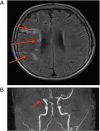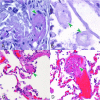Progressive multifocal cerebral infarction in a young kidney transplant recipient due to thrombotic microangiopathy
- PMID: 24708483
- PMCID: PMC4234137
- DOI: 10.1186/1471-2369-15-59
Progressive multifocal cerebral infarction in a young kidney transplant recipient due to thrombotic microangiopathy
Abstract
Background: Renal transplant recipients frequently experience neurological complications. Whereas ischemic stroke, cerebral haemorrhage or hypertensive encephalopathy often result from vascular alterations prior to transplantation, other cerebral diseases like CNS infections, primary brain tumors and drug induced neurotoxicity may develop as consequences of the required post-transplant immunosuppressive treatment.
Case presentation: Here we report on an unusual clinical course of a young kidney transplant recipient with a cluster of fulminant necrotic brain lesions within a period of two months due to thrombotic microangiopathy.
Conclusion: Cerebral ischemia in organ transplant recipients should prompt one to consider thrombotic microangiopathy.
Figures



Similar articles
-
De Novo Thrombotic Microangiopathy Immediately After Kidney Transplant in Patients Without Apparent Risk Factors.Exp Clin Transplant. 2016 Apr;14(2):230-4. doi: 10.6002/ect.2014.0089. Epub 2015 May 30. Exp Clin Transplant. 2016. PMID: 26030297
-
Thrombotic Microangiopathy in a Pregnant Woman With Kidney Transplantation: A Case Report.J Obstet Gynaecol Can. 2021 Jul;43(7):874-878. doi: 10.1016/j.jogc.2020.10.018. Epub 2020 Dec 11. J Obstet Gynaecol Can. 2021. PMID: 33310162
-
Thrombotic microangiopathy after kidney transplantation: lessons from a transplant tourist.J Nephrol. 2023 May;36(4):1191-1195. doi: 10.1007/s40620-023-01572-5. Epub 2023 Feb 16. J Nephrol. 2023. PMID: 36795314 No abstract available.
-
De novo thrombotic microangiopathy following simultaneous pancreas and kidney transplantation managed with eculizumab.Nephrology (Carlton). 2017 Feb;22 Suppl 1:23-27. doi: 10.1111/nep.12936. Nephrology (Carlton). 2017. PMID: 28176480 Review.
-
Antiphospholipid syndrome in renal transplantation.Nephrology (Carlton). 2014 Apr;19(4):177-85. doi: 10.1111/nep.12217. Nephrology (Carlton). 2014. PMID: 24548061 Review.
Cited by
-
Extra-renal manifestations of complement-mediated thrombotic microangiopathies.Front Pediatr. 2014 Sep 8;2:97. doi: 10.3389/fped.2014.00097. eCollection 2014. Front Pediatr. 2014. PMID: 25250305 Free PMC article. Review.
-
Metabolic Syndrome and Cardiovascular Disease after Hematopoietic Cell Transplantation: Screening and Preventive Practice Recommendations from the CIBMTR and EBMT.Biol Blood Marrow Transplant. 2016 Aug;22(8):1493-1503. doi: 10.1016/j.bbmt.2016.05.007. Epub 2016 May 14. Biol Blood Marrow Transplant. 2016. PMID: 27184625 Free PMC article.
-
Metabolic syndrome and cardiovascular disease following hematopoietic cell transplantation: screening and preventive practice recommendations from CIBMTR and EBMT.Bone Marrow Transplant. 2017 Feb;52(2):173-182. doi: 10.1038/bmt.2016.203. Epub 2016 Aug 22. Bone Marrow Transplant. 2017. PMID: 27548466 Free PMC article. Review.
-
Thrombotic Microangiopathy After Kidney Transplantation: An Underdiagnosed and Potentially Reversible Entity.Front Med (Lausanne). 2021 Apr 8;8:642864. doi: 10.3389/fmed.2021.642864. eCollection 2021. Front Med (Lausanne). 2021. PMID: 33898482 Free PMC article. Review.
References
Publication types
MeSH terms
LinkOut - more resources
Full Text Sources
Other Literature Sources
Medical

